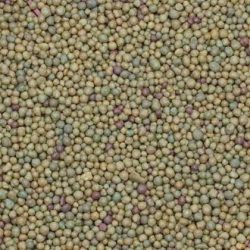
The question of the correct fertilization of clematis is often asked. The fertilizers in use today are more varied than ever before! Which fertilizer is used is a matter of opinion. What are the main differences between mineral fertilizers, stored fertilizers, slow-release fertilizers, liquid fertilizers, nutrient salts, mixed organic/mineral fertilizers, organic fertilizers, vegan fertilizers, organic stimulants and soil additives?
Overview of the various fertilizer substances that are commercially available
| Fertilizer preparation | Duration of effect | Mechanism of action | Advantages | Practical tip |
| Mineral fertilizer Complex fertilizer | 2 – 3 weeks | Water-soluble granules, dissolves quickly | Fast initial effect | No long-term effect |
| Stock fertilizer Complex fertilizer | 6 – 12 weeks | Granules dissolve slowly over time | Easy to use | Hardly any overfertilization |
| Slow-release fertilizer Complex fertilizer | 3 – 12 months depending on the preparation | Coated fertilizer with membrane effect | Continuous nutrient release | Familiarization helpful and improves the effect |
| Liquid fertilizer Complex fertilizer | 5 – 7 days | Dissolved in irrigation water | Immediate effect | Short effect |
| Nutrient salt complete fertilizer, single-nutrient fertilizer | 7 – 14 | Dissolve in the irrigation water | High percentage, quick effect Very economical! | No long-term effect |
| Mixed fertilizer, organic-mineral Complete fertilizer | 3 – 6 weeks | Granules, partly water-soluble and microbiological | Easy to use | Low nutritional values |
| Organic fertilizer Complete fertilizer or single-nutrient fertilizer | 3 – 30 weeks | Microorganisms convert the substance into plant-available nutrients. | Simple application, low salt content | Incorporate, low nutritional values. |
| Vegan fertilizers Mostly complete fertilizers | 2 – 12 weeks | Microorganisms convert the substance into plant-available nutrients. | No salt damage, low Co2 load | Incorporate, low nutritional values. |
| Bio-stimulants 1 – 3 different components | Up to one year | Soil fungi and bacteria that occupy niches and form symbioses | Without chemical additives | Some highly effective substances |
| Soil – additives Mostly one substance | 6 – 18 months | Water reservoir, air reservoir, loosening up | Is helpful for soil improvement | Many different substances are available |
| Lime (PH value increase) | 6 – 8 months | Water-soluble, powder or granules | Improves soil life | Important cell building block! Indispensable for acidic soils! |
| Trace elements, Micronutrients such as: Mg, Fe, Cu, B, Mn, Mo, Zn | 3 – 6 months in most Contains complete fertilizers | Water-soluble powder or liquid | Improves leaf coloration, assimilation and many important processes | Indispensable cell building blocks |
I have deliberately refrained from naming individual preparations here, because everyone prefers a favorite fertilizer that is used. Rose fertilizer, perennial fertilizer, flower fertilizer or tree fertilizer can be used. You can get them in garden centers, country stores, DIY stores, nurseries or discount stores.
When fertilizing clematis, it is important to use a dosage that is adapted to the plant’s development!
The manufacturer’s instructions must be strictly adhered to, because a lot does not help a lot!
Complete fertilizer
Complete fertilizers (NPK), as the name suggests, contain all the main nutrients and trace elements! The various types of fertilizer differ in their composition, sometimes significantly. The higher the numbers, the higher the fertilizer yield!
Example: NPK stands for: N = Nitrogenium Nitrogen, P = Phosphorus, K = Potassium. The letters are accompanied by numbers that indicate the percentage of the individual nutrients.
After prolonged rainfall, it makes sense to top up with a single-nutrient fertilizer, as N = nitrogen and Ca = lime in particular are quickly washed out and are no longer available to the plants. Yellowing is the result and increases rapidly.
A very popular, pure nitrogen fertilizer is horn shavings. It can take several months before the desired fertilizing effect is achieved, as soil organisms must first convert the substance and make it available to plants. This depends particularly on the temperature and humidity. The misconception that horn shavings alone are sufficient as a fertilizer is clearly answered at this point with “no is not enough”.
Organic fertilizer
An important note on the popular organic fertilizers. Most of these fertilizers come from factory farming. (horn meal, horn shavings, bone meal, guano, etc.) For example, the use of sheep’s wool as a fertilizer is new. Vegan fertilizers are becoming increasingly important. The use of green manure (alfalfa and legumes) should not be ignored either.
This contrasts with today’s high-tech fertilizers, which are becoming ever more sophisticated and efficient, also in terms of environmental compatibility and groundwater protection.
